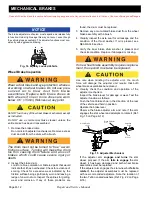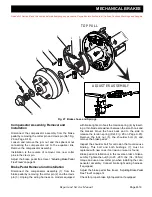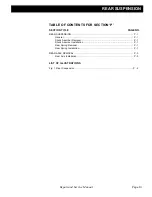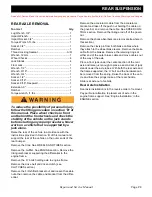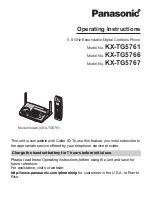
Page M-12
MECHANICAL BRAKES
Repair and Service Manual
Read all of Section B and this section before attempting any procedure. Pay particular attention to all Notices, Cautions, Warnings and Dangers.
The brake adjuster mechanism must expand and release fully
to function. Under light usage this may not occur, even though
the vehicle stops acceptably. The adjuster functions most con-
sistently with aggressive braking.
Fig. 14 Equally Loaded Vehicle
Wheel Brake Inspection
Wear a dust mask and eye protection whenev-
er working on wheel brakes. Do not use pres-
s u r i z e d a i r t o b l o w d u s t f r o m b r a k e
assemblies. Replace both brake shoes on
both wheels if one or more shoes are worn
below .06” (1.5mm) thickness at any point.
Do NOT touch any of the wheel brake mechanism except
as instructed.
Do NOT use a commercial brake cleaner unless the
entire brake has been disassembled.
1. Remove the brake drums.
Do not disturb adjuster mechanisms. Remove excess
dust and dirt from the drum with a brush.
The drum must not be turned to “true” a worn
friction surface. Turning will make the drum
too thin causing drum failure and a loss of
brakes which could cause severe injury or
death.
2. Inspect the brake drum.
Look for a blue coloration or blistered paint that would
indicate that it has overheated. Check for evidence of
scoring. Check for excessive wear indicated by the
friction surface being significantly worn and leaving a
ledge of unworn drum. Inspect the splines for galling,
wear and corrosion. If any of these problems are
found, the drum must be replaced.
3. Remove any accumulated brake dust from the wheel
brake assembly with a brush.
4. Visually inspect the axle seal for oil leakage and the
condition of the thrust washer. If oil is present, see
REAR AXLE section.
5. Verify the inner brake drum washer is present and
check its condition. Replace if damaged or missing.
If one wheel brake assembly requires replace-
ment, the second must also be replaced.
Use care when handling the adjuster arm. Too much
force will damage the adjuster and require that both
wheel brake assemblies be replaced.
6. Visually check the condition and operation of the
adjuster mechanism.
Inspect the brake lever for damage or wear. Test the
adjuster function as follows:
Push the front brake shoe in the direction of the rear
of the vehicle and hold in position.
Operate the brake lever.
Observe the brake adjuster arm and note if the arm
engages the star wheel and attempts to rotate it (Ref.
Fig. 15 on Page K-12).
Fig. 15 Adjuster Mechanism
If the adjuster arm
engages and turns
the star
wheel, proceed. If the arm
fails to engage
the star
wheel, it has been damaged and both wheel brake
assemblies must be replaced.
If the adjuster arm engages the star wheel but
fails to
rotate it
, the adjuster assemblies must be replaced
with new color-coded adjusters. Note the location of
the two Teflon coated washers (Ref. Fig. 22 on Page
K-16).
NOTICE
Brake Adjuster
Arm
Star
Wheel
Adjusting
Screw
Wheel Brake
Lever















